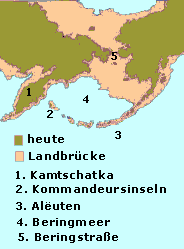the Evolution (Continued)
The lineage of the Hydrodamalinae
*)after Domning, 1978:

| Species |
Time approx. |
Characteristics |
| Dusisiren reinharti |
Early/middle Myocene |
dugong sized, tusks |
| Dusisiren jordani |
10-12 mya |
Size increased, no more tusks. |
| Dusisiren dewana |
9-10mya |
Teeth and hands reduced |
| Hydrodamalis cuestae |
3,6 - 1.8 mya |
Body size double that of previous, up to 10 meters long, metacarpals/carpals reduced, phalanges evidently lost, no teeth in adults.
Probably widest distribution of the Hydrodamalinae. |
| Hydrodamalis gigas |
~200.000 to recent
(extinct) |
Approx. 8 meters long, no teeth, metacarpals unknown |
Steller's Seacow populated the coasts from northern California, along the Aleutians and Kamchatka, to Japan. The exposed shallow, rocky shores of the cold northern Pacific, up to the drift ice border, had become their habitat. There they moved around feeding, "walking" on their forelegs over the ground, manoeuvring with them in the waves between the rocks, and probably using them to uproot vegetation. Steller wrote about their locomotion
*)in de Bestiis
(Miller's translation, Page 25),
With a gentle sidewise motion
of its tail it swims gently forward; with an up-and-down motion of the tail it drives itself violently forward and struggles to escape from the hands of enemies who are trying to draw it in.
The animals have never been observed to be diving, neither to reach food at greater depth nor to escape enemies. Probably they were too buoyant to be able to fully submerge. Their backs and part of the body were always seen above the surface, where it could take up solar heat, and sea gulls could free them from parasites.
They have been on their way back to their amphibious, 50 million year old roots.
These changes took place over long periods in little moves, the major steps are testified by many fossil finds
*)see Domning 1978 and 1987.
The end of this evolution chain was this bulky, clumsy animal, which Steller saw, and which is no longer around. It shared its fate with the other giant animal species of the so called pleistocene megafauna, which populated the earth 20,000 years ago, and which became extinct by the end of the last ice age. There are three major theories that attempt to explain why these species went extinct so quickly. The possible causes can be summarized as "kill, chill and ill"
*) from Wikipedia.

Apropos kill: Approximately 20,000 years ago Homo sapiens migrated into eastern Siberia and from there crossed the then dry Bering Strait. It can be assumed that since then the easily preyed large seacows have been under heavy hunting pressure. Whether human predation alone has reduced them to the small Commander Island (and probably into the 18th century also the western Aleutians) population, is difficult to prove.
Apropos chill: After the end of the last ice age 10,000 years ago, the sea level had risen by more than 100 meters, and the Bering Strait was open again. Cold arctic water flushed into the Bering Sea, and life became quite uncomfortable for the seacows. Now these immobile animals were unable to leave their Commander Island refuge. The fate of the seacows was now foreseeable. Daryl Domning
*)1978, Page 96 assumed that the Commander Islands already were a climatically marginal habitat for them, whose growth obviously stunted due to the prevailing harsh conditions. Most probably their reproduction rate already was considerably negative.
As it seems, this interesting animal was at the edge of natural extinction. Even if in the 18th century the fur hunters would have avoided the islands, the species would no longer be present.
 Apropos kill: Approximately 20,000 years ago Homo sapiens migrated into eastern Siberia and from there crossed the then dry Bering Strait. It can be assumed that since then the easily preyed large seacows have been under heavy hunting pressure. Whether human predation alone has reduced them to the small Commander Island (and probably into the 18th century also the western Aleutians) population, is difficult to prove.
Apropos kill: Approximately 20,000 years ago Homo sapiens migrated into eastern Siberia and from there crossed the then dry Bering Strait. It can be assumed that since then the easily preyed large seacows have been under heavy hunting pressure. Whether human predation alone has reduced them to the small Commander Island (and probably into the 18th century also the western Aleutians) population, is difficult to prove.